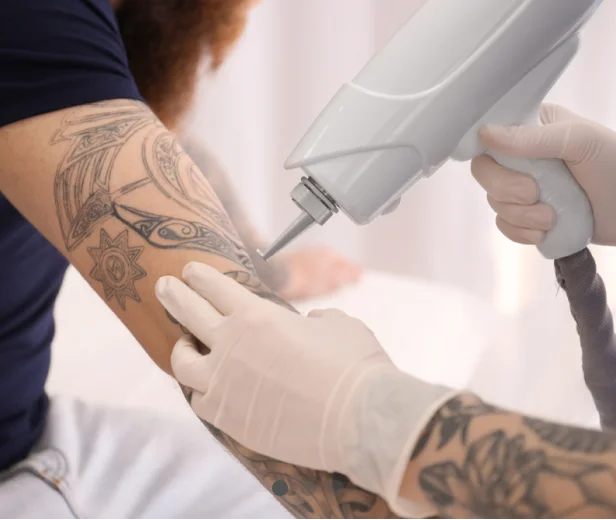How Lasers Remove Tattoos

How Lasers Remove Tattoos: A Comprehensive Breakdown
Tattoos have long been a way for people to express their identity, commemorate meaningful experiences, or simply enjoy the art of body decoration. However, not all ink lasts forever—at least not in intention. Whether due to personal regret, professional requirements, or lifestyle changes, the need for tattoo removal is on the rise. Among all available methods, laser tattoo removal stands as the most advanced, effective, and precise option. But how exactly do lasers work to remove tattoos?
The Science of Tattooing and Why Tattoos Are “Permanent”
To understand how lasers remove tattoos, it’s important to first grasp what makes tattoos so enduring. When you receive a tattoo, a needle deposits ink pigments into the dermis, the skin layer beneath the epidermis. The dermis is less prone to shedding compared to the outer layer of skin, which is why tattoos do not fade with everyday wear and tear.
However, permanence also depends on another crucial factor—your immune system. When ink is introduced into the skin, the body recognizes the pigments as foreign substances. Immune cells, such as macrophages, attempt to remove these particles. Although many cells succeed in carrying minuscule particles away, the majority of pigment particles are too large for cells to ingest. Thus, the ink settles within the dermis and becomes semi-permanent.
This deeply embedded ink, coupled with its interaction with your immune system, is what makes tattoo removal such a challenging process. Enter laser tattoo removal—a breakthrough technology designed to break ink particles down to a size your immune system can eliminate.
What Is Laser Tattoo Removal?
Laser tattoo removal is a non-invasive medical procedure that uses laser technology to target and fragment tattoo ink particles within the skin. Unlike older, more abrasive tattoo removal methods (chemical peels, dermabrasion, salabrasion), lasers are safe and capable of penetrating precise depths, leaving surrounding tissues unaffected.
This technique rests on the principle of selective photothermolysis. Essentially, this means that the laser is finely tuned to deliver intense bursts of energy to the ink particles while sparing the surrounding skin. The specificity of this process ensures that tattoo removal is both efficient and minimally invasive.
How Laser Tattoo Removal Works Step-By-Step
Step 1: Energy Penetrates the Skin
During a laser treatment, a calibrated laser emits short but powerful pulses of light. These light pulses are absorbed by the tattoo ink while leaving the surrounding skin largely unaffected. This occurs because the laser is tuned to a wavelength that matches the color spectrum of the ink, leveraging the concept of light absorption and resonance.
For example:
- Black ink, being the most universal absorber, is the easiest to treat.
- Colors such as green and blue may require more advanced laser wavelengths.
- Lighter inks like yellow and white absorb less light and are therefore more challenging to remove.
Step 2: Thermal Energy Breaks Down Ink Particles
Once the laser light is absorbed, it is converted into heat energy. This heat causes the ink particles to shatter into smaller fragments. The process is instantaneous, occurring in nanoseconds. This fragmentation reduces the size of the particles to a degree that makes them removable by immune cells.
Step 3: Immune System Reclaims the Ink
After the ink particles are shattered, the body’s immune system steps in to complete the process. Macrophages and other immune cells transport these tiny fragments away via the lymphatic system. Over time—and with successive treatments—you’ll notice the area becoming lighter as more and more ink particles are cleared.
Factors Affecting Laser Tattoo Removal Results
Tattoo removal is rarely “one treatment fits all” because every tattoo is unique. Several factors influence the process:
- Ink Color
Dark pigments (black and dark blue) respond quickly to laser treatments, while brighter colors (green, yellow) require more sessions.
- Tattoo Depth and Density
Tattoos applied deeper into the dermis or with heavy ink density will take longer to remove, as more pigment particles need to be targeted and fragmented.
- Skin Type
The Fitzpatrick skin type scale plays a critical role. Darker skin tends to absorb more light energy, requiring a more cautious approach to avoid hyperpigmentation.
- Age of the Tattoo
Tattoos naturally fade over time as your immune system breaks down small particles. Older tattoos often respond better to laser treatments than newer ones.
- Tattoo Location
Tattoos closer to the heart, such as those on the chest or upper arms, fade faster because of better blood circulation that aids the immune system.
- Ink Composition
Tattoo inks are not standardized, and ingredients can vary. Some inks, especially metallic-based ones, may be more difficult to remove.
Why Laser Technology Is Superior for Tattoo Removal
Compared to older techniques, laser tattoo removal presents remarkable advantages:
- Precision
Lasers can zero in on tattoo pigments without damaging surrounding tissues, mitigating the risk of scarring or infection.
- Minimal Downtime
Most individuals experience only mild redness or swelling, which subsides within a few days.
- Custom Wavelengths for Different Colors
Advanced technologies like Q-Switched lasers and Pico lasers ensure effective removal across the ink color spectrum.
- Safety
Unlike chemical or surgical methods, laser treatments preserve the structural integrity of the skin.
What Results Can You Expect?
Complete tattoo removal requires multiple sessions—typically six to ten, depending on the factors we’ve discussed. Treatment intervals usually range from six to eight weeks, allowing your immune system the time it needs to process the ink fragments.
Although the majority of tattoos can be fully eliminated, some residual shadowing may persist for complex colors or older inks. Laser Eraser’s specialists can assess your specific needs during your consultation and recommend a personalized treatment plan.
Are There Side Effects?
Most patients tolerate laser tattoo removal well. However, some common, temporary side effects may include:
- Redness
- Swelling
- Crusting or scabbing
- Brief discoloration (hyperpigmentation or hypopigmentation)
Adverse effects are rare when the procedure is handled by trained professionals using advanced equipment, making lasers the safest tattoo removal technology available today.
Achieve Clear Skin With Laser Eraser
By understanding the science behind laser tattoo removal, you’re empowered to make informed decisions about achieving your desired results. Whether you’re looking to erase a tattoo completely or fade it to make room for new ink, lasers provide a reliable and minimally invasive solution.
At Laser Eraser, we combine cutting-edge technology with the expertise of trained specialists to ensure safe and effective tattoo removal tailored to your needs. Schedule a consultation today, and take the first step toward clear, ink-free skin.

